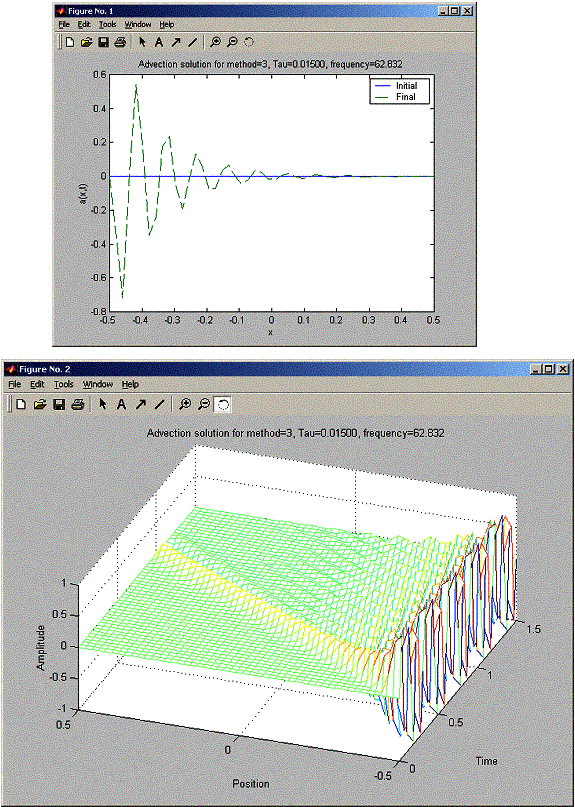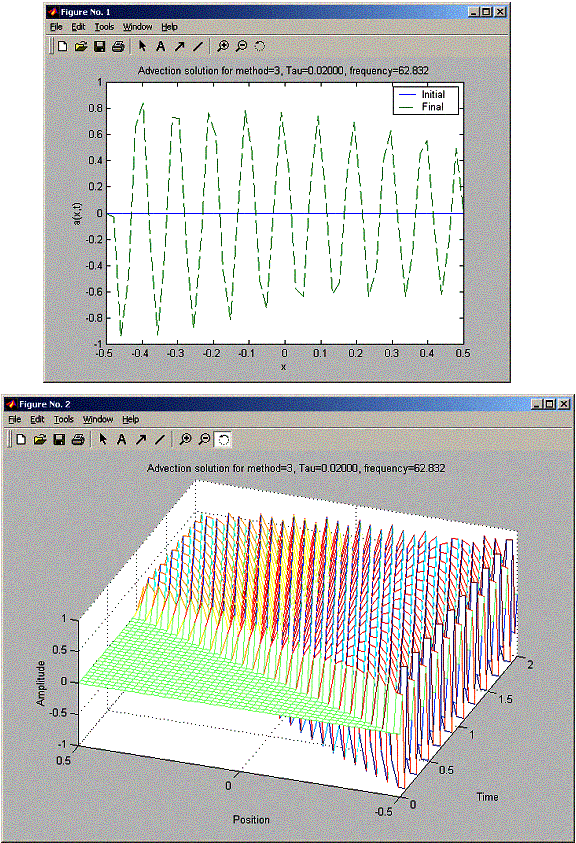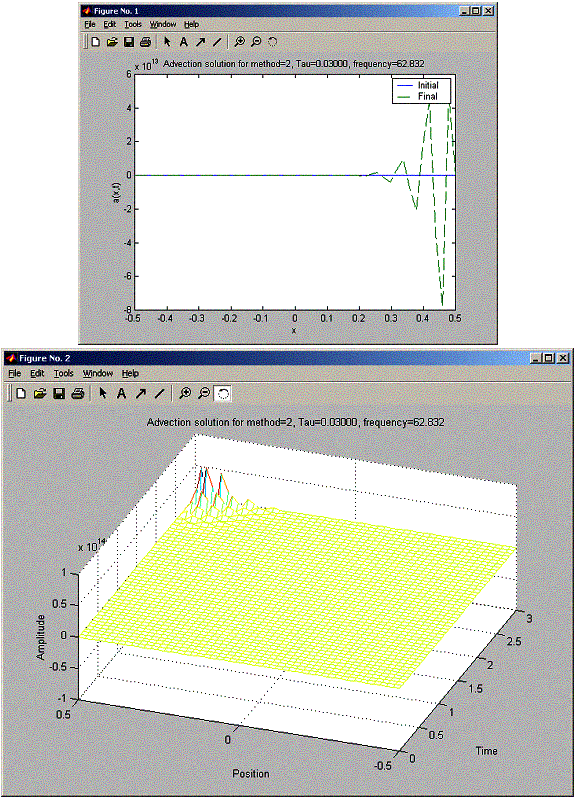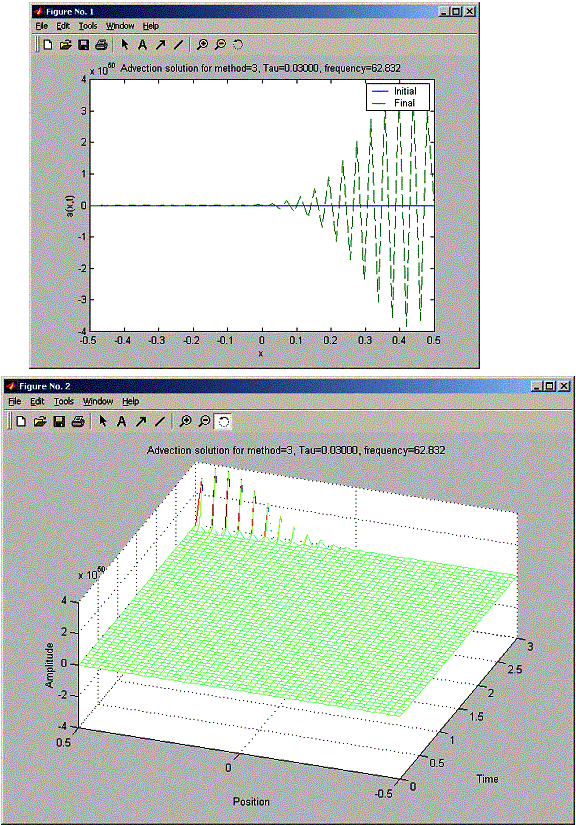7.2
Nasser Abbasi
OUTPUT
I first show the output for the three methods, for tau=0.015, 0.02 and 0.03, all for frequency 10*pi.
Conclusion for frequency 10*pi :
h = 0.0204 for all these problems. So h/c = 0.0204 seconds. When trying for tau for 0.015, 0.02, and 0.03, FTCS was unstable for all tau, and the stability becames worst as tau increased (amplitude at final was much larger as tau increased). For the Lax method, when tau was less than 0.02, there was a damping in the final sin amplitude as x increased from –L/2 to L/2. While the Lax-Wendroff did not suffer from this damping. At Tau 0.02, Lax and Lax-Wendroff looked the same. At tau = 0.03 Lax-Wendroff became unstable earlier than Lax. The final plot shows Lax-Wendroff starting to blow up at x= 0.1L, while Lax managed to hold well until x=0.3L, but still at X=L/2, Lax had much smaller blow up signal amplitude than Lax-Wendroff.
When doubling the frequency of the sin signal. At tau below 0.02, Lax damps more than at the lower freuqncy (lower amplitude at final for tau=20pi compared to 10pi frequency),
Also Lax-Wendroff at double the frequency damps more. At tau=0.03,
»
nma_advect_problem_7_2
nma_advect_problem_7_2 - Program to solve
the
advection equation using the various hyperbolic
PDE schemes
solves problem 7.2 in book
Nasser Abbasi
select
numerical method: FTCS=1, Lax=2
Lax-Wendroff=3 :1
You selected method 1
Enter
number of grid points: 50
Enter
the frequncy w of the sin signal at the bounday:10*pi
Time
for wave to move one grid spacing is 0.0204082
Enter time step: 0.015
Enter
number of steps: 160

»
nma_advect_problem_7_2
nma_advect_problem_7_2 - Program to solve
the
advection equation using the various
hyperbolic PDE schemes
solves problem 7.2 in book
Nasser Abbasi
select
numerical method: FTCS=1, Lax=2
Lax-Wendroff=3 :2
You selected method 2
Enter
number of grid points: 50
Enter
the frequncy w of the sin signal at the bounday:10*pi
Time
for wave to move one grid spacing is 0.0204082
Enter time step: 0.015
Enter
number of steps: 100
»

»
nma_advect_problem_7_2
nma_advect_problem_7_2 - Program to solve
the
advection equation using the various
hyperbolic PDE schemes
solves problem 7.2 in book
Nasser Abbasi
select
numerical method: FTCS=1, Lax=2
Lax-Wendroff=3 :3
You selected method 3
Enter
number of grid points: 50
Enter
the frequncy w of the sin signal at the bounday:10*pi
Time
for wave to move one grid spacing is 0.0204082
Enter time step: 0.015
Enter
number of steps: 100
»

» nma_advect_problem_7_2
nma_advect_problem_7_2 - Program to solve the
advection equation using the various hyperbolic PDE schemes
solves problem 7.2 in book
Nasser Abbasi
select numerical method: FTCS=1, Lax=2 Lax-Wendroff=3 :1
You selected method 1
Enter number of grid points: 50
Enter the frequncy w of the sin signal at the bounday:10*pi
Time for wave to move one grid spacing is 0.0204082
Enter time step: 0.02
Enter number of steps: 150

» nma_advect_problem_7_2
nma_advect_problem_7_2 - Program to solve the
advection equation using the various hyperbolic PDE schemes
solves problem 7.2 in book
Nasser Abbasi
select numerical method: FTCS=1, Lax=2 Lax-Wendroff=3 :2
You selected method 2
Enter number of grid points: 50
Enter the frequncy w of the sin signal at the bounday:10*pi
Time for wave to move one grid spacing is 0.0204082
Enter time step: 0.02
Enter number of steps: 100
»

» nma_advect_problem_7_2
nma_advect_problem_7_2 - Program to solve the
advection equation using the various hyperbolic PDE schemes
solves problem 7.2 in book
Nasser Abbasi
select numerical method: FTCS=1, Lax=2 Lax-Wendroff=3 :3
You selected method 3
Enter number of grid points: 50
Enter the frequncy w of the sin signal at the bounday:10*pi
Time for wave to move one grid spacing is 0.0204082
Enter time step: 0.02
Enter number of steps: 100

» nma_advect_problem_7_2
nma_advect_problem_7_2 - Program to solve the
advection equation using the various hyperbolic PDE schemes
solves problem 7.2 in book
Nasser Abbasi
select numerical method: FTCS=1, Lax=2 Lax-Wendroff=3 :1
You selected method 1
Enter number of grid points: 50
Enter the frequncy w of the sin signal at the bounday:10*pi
Time for wave to move one grid spacing is 0.0204082
Enter time step: 0.03
Enter number of steps: 150
»

» nma_advect_problem_7_2
nma_advect_problem_7_2 - Program to solve the
advection equation using the various hyperbolic PDE schemes
solves problem 7.2 in book
Nasser Abbasi
select numerical method: FTCS=1, Lax=2 Lax-Wendroff=3 :2
You selected method 2
Enter number of grid points: 50
Enter the frequncy w of the sin signal at the bounday:10*pi
Time for wave to move one grid spacing is 0.0204082
Enter time step: 0.03
Enter number of steps: 100
»

» nma_advect_problem_7_2
nma_advect_problem_7_2 - Program to solve the
advection equation using the various hyperbolic PDE schemes
solves problem 7.2 in book
Nasser Abbasi
select numerical method: FTCS=1, Lax=2 Lax-Wendroff=3 :3
You selected method 3
Enter number of grid points: 50
Enter the frequncy w of the sin signal at the bounday:10*pi
Time for wave to move one grid spacing is 0.0204082
Enter time step: 0.03
Enter number of steps: 100
»

» nma_advect_problem_7_2
nma_advect_problem_7_2 - Program to solve the
advection equation using the various hyperbolic PDE schemes
solves problem 7.2 in book
Nasser Abbasi
select numerical method: FTCS=1, Lax=2 Lax-Wendroff=3 :2
You selected method 2
Enter number of grid points: 50
Enter the frequncy w of the sin signal at the bounday:20*pi
Time for wave to move one grid spacing is 0.0204082
Enter time step: 0.015
Enter number of steps: 100
»

» nma_advect_problem_7_2
nma_advect_problem_7_2 - Program to solve the
advection equation using the various hyperbolic PDE schemes
solves problem 7.2 in book
Nasser Abbasi
select numerical method: FTCS=1, Lax=2 Lax-Wendroff=3 :3
You selected method 3
Enter number of grid points: 50
Enter the frequncy w of the sin signal at the bounday:20*pi
Time for wave to move one grid spacing is 0.0204082
Enter time step: 0.015
Enter number of steps: 100
»

» nma_advect_problem_7_2
nma_advect_problem_7_2 - Program to solve the
advection equation using the various hyperbolic PDE schemes
solves problem 7.2 in book
Nasser Abbasi
select numerical method: FTCS=1, Lax=2 Lax-Wendroff=3 :2
You selected method 2
Enter number of grid points: 50
Enter the frequncy w of the sin signal at the bounday:20*pi
Time for wave to move one grid spacing is 0.0204082
Enter time step: 0.02
Enter number of steps: 100

» nma_advect_problem_7_2
nma_advect_problem_7_2 - Program to solve the
advection equation using the various hyperbolic PDE schemes
solves problem 7.2 in book
Nasser Abbasi
select numerical method: FTCS=1, Lax=2 Lax-Wendroff=3 :3
You selected method 3
Enter number of grid points: 50
Enter the frequncy w of the sin signal at the bounday:20*pi
Time for wave to move one grid spacing is 0.0204082
Enter time step: 0.02
Enter number of steps: 100

» nma_advect_problem_7_2
nma_advect_problem_7_2 - Program to solve the
advection equation using the various hyperbolic PDE schemes
solves problem 7.2 in book
Nasser Abbasi
select numerical method: FTCS=1, Lax=2 Lax-Wendroff=3 :2
You selected method 2
Enter number of grid points: 50
Enter the frequncy w of the sin signal at the bounday:20*pi
Time for wave to move one grid spacing is 0.0204082
Enter time step: 0.03
Enter number of steps: 100

» nma_advect_problem_7_2
nma_advect_problem_7_2 - Program to solve the
advection equation using the various hyperbolic PDE schemes
solves problem 7.2 in book
Nasser Abbasi
select numerical method: FTCS=1, Lax=2 Lax-Wendroff=3 :3
You selected method 3
Enter number of grid points: 50
Enter the frequncy w of the sin signal at the bounday:20*pi
Time for wave to move one grid spacing is 0.0204082
Enter time step: 0.03
Enter number of steps: 100
»

CODE:
function nma_advect_problem_7_2()
%
nma_advect_problem_7_2 - Program to solve the
%
advection equation using the various hyperbolic PDE schemes
% solves
problem 7.2 in book
% Nasser
Abbasi
clear all; help nma_advect_problem_7_2; % Clear
memory and print header
%*
Select numerical parameters (time step, grid spacing, etc.).
try_again=1;
while(try_again)
method = input('select numerical
method: FTCS=1, Lax=2 Lax-Wendroff=3 :');
if( method<1 | method>3 )
fprintf('Please try again,
choice must be 1 or 2 or 3.\n');
else
try_again=0;
fprintf('You selected method
%d\n',method);
end
end
N = input('Enter
number of grid points: ');
L = 1.;
% System size
%h = L/N;
% Grid spacing FOR PERIODIC B.C.
h = L/(N-1);
% Grid spacing for Dirichlet B.C.
c = 1;
% Wave speed
omega = input('Enter the frequncy w of the sin signal at the
bounday:');
fprintf('Time for wave to move one grid spacing is %g\n',h/c);
tau = input('Enter time step: ');
coeff = -c*tau/(2.*h); % Coefficient used by all schemes
coefflw = 2*coeff^2; %
Coefficient used by L-W scheme
%fprintf('Wave
circles system in %g steps\n',L/(c*tau));
nStep = input('Enter
number of steps: ');
%* Set
Initial conditions.
sigma = 0.1; % Width of the
Gaussian pulse
k_wave = pi/sigma; % Wave number of the
cosine
%x = ((1:N)-1/2)*h - L/2; % Coordinates of grid points for periodic.
x = ((1:N)-1)*h - L/2; %
Coordinates of grid points for Dirichlet
% set
Initial conditions as a Gaussian-cosine pulse
%a = cos(k_wave*x) .*
exp(-x.^2/(2*sigma^2));
a=zeros(N,1);
% Use
periodic boundary conditions
%ip(1:(N-1))
= 2:N;
%ip(N) =
1; % ip = i+1 with periodic b.c.
%im(2:N) = 1:(N-1);
%im(1) =
N; % im = i-1 with periodic b.c.
%use
Dirichlet
ip(1:N-2) = 3:N;
im(1:N-2) = 1:N-2;
%*
Initialize plotting variables.
iplot = 1; % Plot counter
aplot(:,1) = a(:); %
Record the initial state
tplot(1) = 0; % Record the initial
time (t=0)
nplots = 50; % Desired number of
plots
plotStep = nStep/nplots; %
Number of steps between plots
%* Loop
over desired number of steps.
for iStep=1:nStep %% MAIN LOOP
%%
%* Compute new values of wave amplitude
using FTCS,
%
Lax or Lax-Wendroff method.
if( method == 1 ) %%% FTCS
method %%%
a(1) = sin(omega*(iStep)*tau);
a(N) = 0;
a(2:N-1) = a(2:N-1) + coeff*(a(ip)-a(im));
else
if( method == 2 )
%%% Lax method %%%
a(1) = sin(omega*(iStep)*tau);
a(N) = 0;
a(2:N-1) = .5*(a(ip)+a(im)) + coeff*(a(ip)-a(im));
else %%%
Lax-Wendroff method %%%
a(1) = sin(omega*(iStep)*tau);
a(N) = 0;
a(2:N-1) = a(2:N-1) + coeff*(a(ip)-a(im)) + ...
coefflw*(a(ip)+a(im)-2*a(2:N-1));
end
end
%* Periodically record a(t) for
plotting.
if( rem(iStep,plotStep) < 1
) %
Every plot_iter steps record
iplot =
iplot+1;
aplot(:,iplot) = a(:);
% Record a(i) for ploting
tplot(iplot) =
tau*iStep;
%fprintf('%g out of %g steps
completed\n',iStep,nStep);
end
end
%* Plot
the initial and final states.
figure(1);
clf; % Clear
figure 1 window and bring forward
plot(x,aplot(:,1),'-',x,a,'--');
legend('Initial ','Final');
xlabel('x');
ylabel('a(x,t)');
title(sprintf('Advection solution for method=%d, Tau=%1.5f,
frequency=%3.3f',method,tau,omega));
pause(1); % Pause 1
second between plots
%* Plot
the wave amplitude versus position and time
figure(2); clf; % Clear
figure 2 window and bring forward
mesh(tplot,x,aplot);
ylabel('Position');
xlabel('Time'); zlabel('Amplitude');
view([-70 50]); % Better view
from this angle
title(sprintf('Advection solution for method=%d, Tau=%1.5f,
frequency=%3.3f',method,tau,omega));